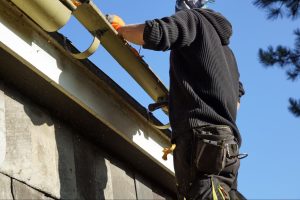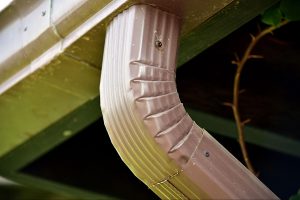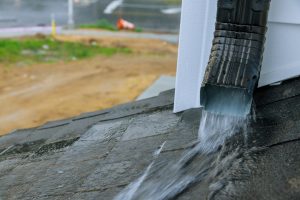Your roof may get the spotlight when it comes to protecting your home, but the supporting cast—your soffit, fascia, and gutters—play equally vital roles. These often-overlooked components help ventilate your attic, protect your roofline, and guide rainwater safely away from your structure. When one element fails, it puts the entire system at risk. That’s why understanding how soffit and fascia repair works with gutter maintenance is key to preserving the structural integrity, appearance, and longevity of your home.
What Are Soffit and Fascia?
Soffit and fascia may not be as visible as your shingles or siding, but they play a critical role in protecting your roofline and supporting your gutter system. Before diving into repairs and maintenance, it’s essential to understand what each component does and how they work together.
Soffit: Ventilation and Protection
The soffit is the exposed underside of your roof’s overhang. It helps ventilate the attic and prevents moisture buildup inside your roofing system. Most soffits are made from aluminum, vinyl, or wood and are designed to allow airflow while protecting your rafters from weather and pests. If your soffit is damaged or clogged, attic air can stagnate, leading to mold growth, ice dams, and heat buildup.
Fascia: Structural Support and Gutter Mounting
The fascia is the horizontal band that runs along the edge of the roof where the gutters are attached. It serves as a support board for the lower edge of the roof and acts as a mounting surface for the gutter system. A compromised fascia board can weaken your gutter’s stability and lead to sagging leaks or complete detachment during heavy storms.
The Connection Between Soffit, Fascia, and Gutters
Your soffit, fascia, and gutter system work together as a unit to protect your home from water damage. When water isn’t properly channeled away due to clogged or broken gutters, it can overflow and saturate the fascia boards. From there, moisture can creep into the soffit and eventually into your attic. Likewise, if the fascia begins to rot or crack, it can no longer support your gutters, which then sag or pull away, worsening drainage issues. It’s a domino effect—when one piece fails, the others follow.
Why Gutter Maintenance is Critical to Soffit and Fascia Repair
Even a perfectly installed soffit and fascia system can fail if your gutters aren’t properly maintained. This section explores how clogged or damaged gutters directly impact the condition and longevity of your soffit and fascia.
Preventing Water Overflow
Clogged gutters overflow during heavy rain, sending water down the face of your fascia boards and into the soffit vents. This constant saturation causes wood rot, mold, and potential structural failure. Regularly cleaning your gutters—especially during fall and spring—keeps water flowing where it belongs.
Reducing Ice Dams and Moisture Intrusion
In colder climates, blocked gutters contribute to the formation of ice dams. When water freezes at the roof edge and can’t drain properly, it backs up under the shingles and into the soffit and fascia. Keeping gutters free of obstructions minimizes this risk and protects your home during winter months.
Protecting Structural Integrity
Even the best gutter system will fail if it’s mounted to a rotting fascia. When fascia boards degrade due to persistent moisture exposure, they lose their strength and can no longer hold the weight of the gutters—especially during storms or when filled with debris. Maintaining gutters helps support the longevity of the fascia boards and prevents premature failure.

How Soffit and Fascia Repair is Done
Repairing soffit and fascia involves more than just replacing trim boards—it requires careful assessment, proper tools, and coordination with the gutter system. Here’s a step-by-step look at how professionals approach the repair process to ensure long-lasting results:
Step 1: Inspection and Damage Assessment
The first step in any soffit and fascia repair is a detailed inspection. Contractors look for visible rot, warping, moisture damage, pest nests, and peeling paint. They may also check for signs of mold or attic ventilation issues. The condition of the connected gutter system is also reviewed to identify whether the root cause stems from poor drainage.
Step 2: Gutter Removal and Protection
Before repairs can begin, the gutter system is temporarily removed or safely braced to access the damaged fascia boards and soffit panels. In many cases, this step reveals hidden water damage or pests that weren’t visible during the initial inspection.
Step 3: Replacing or Repairing Fascia Boards
Fascia boards are removed and replaced if they show signs of rot, cracking, or separation. New boards are typically made from treated lumber, aluminum, or composite materials for increased durability. The new boards are sealed, painted, or capped with aluminum wrap for added weather protection. If only minor damage is found, patching or reinforcing the existing board may be an option.
Step 4: Soffit Panel Installation
Damaged soffit panels are removed and replaced with vented or solid soffit, depending on the home’s ventilation needs. New soffit material is installed snugly into place and sealed to prevent pest entry and moisture infiltration. Vinyl or aluminum soffits are often used as long-lasting, low-maintenance options.
Step 5: Gutter Reinstallation and Alignment
Once the soffit and fascia repairs are complete, the gutter system is reattached or replaced as needed. Proper pitch and alignment are checked to ensure water flows smoothly to the downspouts. Brackets and hangers are reinforced to guarantee secure mounting.
Step 6: Final Sealing and Paint Touch-Ups
Caulking, sealing, and painting are done to protect the new wood and provide a seamless appearance. Flashing may also be installed where necessary to divert water away from vulnerable seams and junctions.
The Role of Gutter Guards and Covers in Soffit and Fascia Repair
Gutter guards do more than keep leaves out—they help protect your soffit and fascia from water damage caused by clogs and overflow. This section explains how adding guards or covers can extend the life of your repairs and reduce future maintenance:
Keeping Debris Out
Installing gutter guards helps keep leaves, twigs, and roof grit from clogging your gutters. This simple add-on significantly reduces the likelihood of overflows, thereby protecting the soffit and fascia from water damage.
Reducing Maintenance Frequency
With gutter guards in place, homeowners can extend the time between gutter cleanings and lower the risk of ice dams. This extension reduces stress on fascia boards and helps preserve the health of your roofline.
Supporting Long-Term Repair Efforts
Gutter guards pair well with fresh soffit and fascia repairs by minimizing future maintenance needs and ensuring the improvements last longer. When installed after a repair, they help protect your investment.
How Often Should You Inspect Soffit, Fascia, and Gutters?
Twice a year is ideal—once in the spring and again in the fall—for inspecting your soffit, fascia, and gutters. Additional checks are smart after major storms, when you notice gutter overflow, if pests are entering your roofline, or before repainting or residing in your home. Routine inspections help catch damage early, allowing you to coordinate soffit and fascia repairs before issues spread to other areas of your home.
DIY vs. Professional Soffit and Fascia Repair
While some homeowners may consider tackling soffit and fascia repairs on their own, these projects often involve hidden risks and complexities that a professional can best address. This section compares the pros and cons of DIY work versus hiring a professional to ensure safe, lasting results:
The Risks of DIY
While handy homeowners may feel comfortable cleaning gutters or repainting fascia trim, complete soffit, and fascia repair is often more complex. It requires working from ladders or scaffolding, removing roofing material, and handling power tools. Improper installation can lead to gaps, leaks, or worse structural issues.
Benefits of Hiring a Pro
Professional contractors possess the necessary tools, materials, and expertise to diagnose underlying issues and perform safe, effective repairs accurately. They also guarantee proper ventilation, water management, and structural alignment—all of which are crucial when tying the repair to an existing gutter system.
Signs It’s Time to Replace Your Gutters During Soffit and Fascia Repair
Sometimes, repairs to the soffit and fascia reveal that the gutter system itself has reached the end of its life. Signs that your gutters may need replacement include rust or corrosion, separated seams or leaking joints, sagging or detachment, water pooling around the foundation, and uneven water flow during rain. If any of these issues are present, replacing the gutters during fascia and soffit repair not only saves time but also ensures that all components function together effectively and protect your home as intended.
Material Options for Long-Term Durability
Modern replacements often include low-maintenance options like:
Vinyl Soffit Panels
Lightweight, moisture-resistant, and vented
Aluminum Fascia Wraps
Corrosion-resistant and no need for painting
Composite Fascia Boards
Rot-resistant and stable under varying conditions
Seamless Aluminum Gutters
Fewer leaks and long-lasting protection
Coordinating Soffit and Fascia Repair and Gutter Maintenance
The most effective approach to roofline protection is coordinated maintenance. By syncing your gutter cleanings with fascia and soffit inspections, you avoid emergency repairs and keep all components in top shape. This proactive approach also reduces the risk of water damage to your siding, attic, and foundation. Many contractors now offer maintenance packages that combine gutter cleaning, soffit and fascia checks, and minor tune-ups. This bundled care model is beneficial for older homes or those with heavy tree coverage.

Why Soffit and Fascia Repair is Essential to Gutter Maintenance
Soffit, fascia, and gutters may seem like minor elements, but together, they form a frontline defense against water damage, pests, and structural decay. When you neglect one, you jeopardize them all. By understanding how soffit and fascia repair works in conjunction with gutter maintenance, homeowners can protect their investment, avoid costly repairs, and ensure their homes remain strong for years to come.
Please visit our Quality Rain Gutters blog for more information about soffit and fascia repair.





